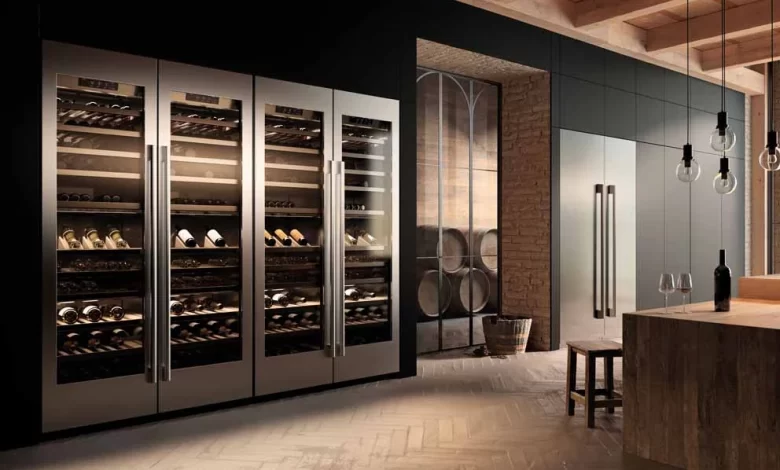Crafting a Kitchen Centerpiece with a Bespoke Wine Cellar

In contemporary design, the concept of the kitchen extends beyond mere functionality, evolving into a statement of personal style and a hub for entertaining. Imagine elevating this central space with a bespoke wine cellar, seamlessly integrated to not only showcase a curated collection but also to serve as a captivating centerpiece. This article delves into the art of crafting such a unique kitchen feature, exploring the considerations, design possibilities, and the undeniable allure of having your prized vintages within arm’s reach.
To truly elevate your culinary space, envision crafting a stunning kitchen centerpiece that seamlessly integrates the sophisticated functionality of a bespoke wine cellar, inspiring you to build a custom wine cellar for your kitchen.
Envisioning the Integration: Functionality Meets Aesthetics
Before embarking on the design journey, it’s crucial to envision how the wine cellar will interact with the existing or planned kitchen layout. Will it be a prominent, walk-in feature commanding attention, or a more subtle, built-in unit that blends seamlessly with the cabinetry? Consider the flow of traffic within the kitchen and ensure the cellar’s placement enhances, rather than hinders, movement.
Functionality is paramount. Determine the desired capacity of the cellar based on your current collection and anticipated growth. Think about the types of wines you collect, as different varietals benefit from specific temperature and humidity levels. This will affect the technical specifications of the cellar, including insulation and cooling systems.
From an aesthetic standpoint, the wine cellar should go well with the general design language of the kitchen.
Whether your style leans towards sleek modernism, rustic charm, or timeless traditionalism, the cellar’s materials, finishes, and lighting should harmonize with the existing elements. While solid wood panels can offer a more discreet and temperature-stable setting, glass doors provide a tempting view of the collection.
Design Considerations: Tailoring to Your Taste and Space
The beauty of a bespoke wine cellar lies in its adaptability to individual preferences and spatial constraints. Several design approaches can be explored:
- The Walk-In Sanctuary: For those with ample space, a walk-in wine cellar transforms a corner or an entire wall into a dedicated haven for wine appreciation. This design allows for extensive storage, often incorporating tasting areas or comfortable seating. Glass enclosures create a visual spectacle, while ensuring optimal climate control.
- The Integrated Cabinetry: A more space-efficient solution involves seamlessly integrating the wine cellar into the kitchen cabinetry. This can take the form of under-counter units, tall pantry-style cabinets with glass doors, or even cleverly concealed compartments. This approach offers a sophisticated and understated way to house a significant collection without overwhelming the kitchen’s footprint.
- The Feature Wall: Transform an entire wall into a striking focal point with a custom-designed wine cellar. This could involve a combination of open shelving to display prized bottles and temperature-controlled sections for long-term storage. Incorporating unique lighting fixtures and backdrops can further enhance its visual impact.
- The Island Innovation: For kitchens with a central island, consider integrating a wine cellar into its design. This could involve refrigerated drawers for everyday wines or a glass-enclosed section at one end, adding a touch of unexpected luxury to this high-traffic area.
Climate Control: Preserving Perfection
The primary function of a wine cellar is to provide an optimal environment for storing and aging wine. Bespoke designs allow for precise climate control, ensuring the longevity and quality of your collection. Key considerations include:
- Temperature: Maintaining a consistent temperature, ideally between 50-55°F (10-13°C), is crucial for slow and even aging.
- Humidity: Controlling humidity levels, ideally between 50-70%, helps to prevent corks from drying out and labels from degrading.
- Ventilation: Proper air circulation helps to maintain consistent temperature and humidity throughout the cellar and prevents the build-up of unwanted odors.
- UV Protection: Minimizing exposure to ultraviolet (UV) light is essential, as it can negatively impact the wine’s flavor and aroma. Tinted glass and solid doors offer protection.
A reputable wine cellar specialist can advise on the most suitable cooling system, insulation materials, and monitoring systems to ensure optimal climate control for your specific needs.
The arrangement of bottles within the cellar is also an opportunity for display. Think about grouping wines by area, kind, or age. Incorporating display shelves for particularly prized bottles can further elevate the visual impact.
The Allure of Proximity: Convenience and Conversation
Beyond its aesthetic appeal, a bespoke wine cellar integrated into the kitchen offers unparalleled convenience. Having your curated collection readily accessible simplifies meal pairings, impromptu gatherings, and the simple pleasure of enjoying a glass of wine without having to venture to a separate part of the house.
Investing in Lasting Luxury
Crafting a kitchen centerpiece with a bespoke wine cellar is an investment in both the functionality and the aesthetic of your home. It elevates the kitchen from a purely utilitarian space to a luxurious and personalized environment. The seamless integration of a well-designed and climate-controlled wine cellar not only preserves your valuable collection but also adds a touch of sophistication and indulgence to your daily life and your entertaining endeavors. It’s a testament to the art of living well, where culinary passions and cultural appreciation converge in the heart of the home.
